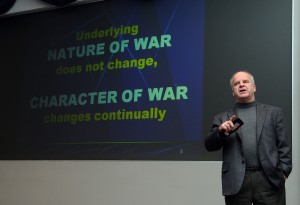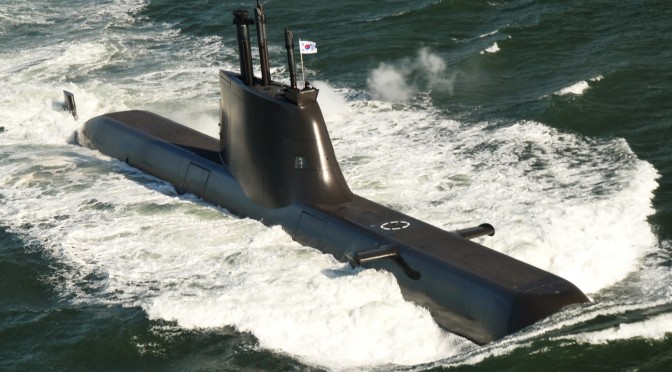To date, the discussion of Air-Sea Battle has provided a great deal of heat but very little light. Worse, it has driven the discussion to the tactical/operational level and confused the strategic discussion. With luck, CIMSEC’s weeklong focus on the subject will add a bit more light.
One of the fundamental problems of any discussion of Air-Sea Battle is determining what the term means in a particular discussion. Even more problematic, the discussion has too often focused on inter-service competition for resources and the procurement necessary to conduct an aggressive anti-A2/AD campaign against China. This has largely blocked the discussion of much more important questions. The first is can the United States maintain the maritime and air dominance that has been the keystone of its military position in Asia since 1945? (ASB seems to be based on the unexamined assumption that we can.) If such dominance is possible, can we afford it? If so, what military strategy would make use of those capabilities to achieve our political goals in the region? Finally, if the political situation, technical developments, or sheer cost make such dominance impossible, what should the U.S. strategy be for dealing both with China’s “creeping expansionism” and a highly unlikely, but potentially devastating, major war with China?
Let’s deal first with why the discussion has created more heat than light to date. As unusual as it is for me to say this—it’s not the Pentagon’s fault. The Pentagon has been very clear about ASB. Both the Chief of Naval Operations and the Chief of Staff of the Air Force have repeatedly stated that ASB is NOT a strategy. The ASB Office’s report from May 2013, Air-Sea Battle: Service Collaboration to Address Anti-Access & Area Denial Challenges. states “ASB is a limited objective concept that describes what is necessary for the joint force to sufficiently shape A2/AD environments to enable concurrent or follow-on power projection operations.” (p. 4) The Joint Staff has reinforced this by declaring that ASB is a supporting concept nested under the Joint Operational Access Concept. The same paper as above also thoughtfully outlined why the Anti-Access/Area Denial systems are a threat to the United States and how the Joint Force can respond. It notes:
While ASB is not a strategy, it is an important component of DoD’s strategic mission to project power and sustain operations in the global commons during peacetime or crisis. Implementation of the ASB Concept, coordinated through the ASB office, is designed to develop the force over the long-term, and will continue to inform institutional, conceptual, and programmatic changes for the Services for years to come. The ASB Concept seeks to provide decision makers with a wide range of options to counter aggression from hostile actors. At the low end of the conflict spectrum, the Concept enables decision makers to maintain freedom of action, conduct a show of force, or conduct limited strikes. At the high end of the conflict spectrum, the Concept preserves the ability to defeat aggression and maintain escalation advantage despite the challenges posed by advanced weapons systems. (p. i) …
The ability to integrate capabilities, equipment, platforms, and units across multiple domains and to communicate, interact, and operate together presents a joint force commander with more numerous and powerful options, which in turn, offer greater probability of operational success. (p. 5)
Despite the Pentagon’s repeated efforts to clarify what it means by Air-Sea Battle, the broader discussion still focuses on the ideas expressed in the Center for Strategic and Budgetary Assessment’s AirSea Battle: A Point-of-Departure Operational Concept. CSBA’s report addresses the very real, and pressing problem of China’s growing ability to threaten U.S. power projection into Asia. Almost all observers agree this is a serious issue that needs addressing. The controversy has evolved not over the definition of the problem but CSBA’s proposed solution. The CSBA concept paper called for a two stage campaign. It is the first stage that is controversial. CSBA calls for the United States and its allies to defeat A2/AD by
- Executing a blinding campaign against PLA battle networks;
- Executing a suppression campaign against PLA long-range, ISR and strike systems;
- Seizing and sustaining the initiative in the air, sea, space and cyber domains.

In short, CSBA calls for not only striking targets inside a thermo-nuclear armed state but actually targeting the command and control of its nuclear forces. In order to suppress China’s long-range cruise and ballistic missiles, the United States will have to strike the command and control systems of the Second Artillery Corps, which, as Thomas Christensen points out, is also responsible for China’s strategic nuclear force. Attacking a thermo-nuclear armed state’s nuclear deterrent in order to gain a limited tactical advantage seems to be enormously risky.
This illustrates a key point about operational concepts. In absence of a strategy, even successful operational concepts can lead to failure. Blitzkrieg was highly successful against France. When used against the Soviet Union, it was an unmitigated disaster. In both countries it worked at the tactical and operational levels. But in the second instance, there was a major mismatch in the ends, ways, and means calculation. German planners assumed the same concept that worked brilliantly in a relatively limited theater like France would work in the expanses of Russia. This assumption ignored history. While the French in the 19th Century stood and fought, and if defeated, surrendered, the Russians had a history of withdrawing deeper into their interior and fighting on.
Thus an operational concept cannot be judged as good or bad unless it is applied to a specific strategy. Perhaps more dangerous is the fact that an operational concept can drive procurement even in the absence of a strategy—even in the total absence of any evidence the concept will work. Prior to World War II, the Royal Air Force’s fundamental operational concept was that strategic bombing could rapidly defeat an enemy. This was based on the dogma that the bomber would always get through. The RAF maintained its faith despite the fact that numerous tests had indicated the bombers often could not find, much less hit, their targets. Tests also indicated that bombers could be intercepted by fighters and thus would face heavy losses if they attempted to fly unescorted missions deep into enemy airspace.
Despite the evidence to the contrary, the RAF continued to push the concept of strategic bombardment. It focused on procurement of heavy bombers to the detriment of fighter forces, radar, and air defense command and control. Only the intervention of civilian leaders forced the RAF to grudgingly shift resources to the air defense network. The civilian intervention proved critical in The Battle of Britain. There is no doubt that early in the war, the British Air Defense Command was much more important to Britain’s survival than Bomber Command. In fact, the concept of Strategic Bombardment never lived up to its promises. While heavy bombardment played a key role in defeating Germany, it did so at only enormous human and financial cost. Even then, it did so only after both the U.S. and Royal Air Forces significantly modified their pre-war strategic bombing concepts.
This highlights why the discussion needs to shift away from the Air-Sea Battle Concept to the higher order questions of strategy and subsequent resource allocation decisions. Guiding U.S. resource allocation may be the area where strategy has the most immediate impact. Obviously, political imperatives will continue to drive a major portion of the U.S. defense budget, but as we face significantly reduced funding over the next decade, clear strategic logic may be a key factor in helping us make hard budgetary choices. Letting an operational concept drive procurement without a strategy would result in a significant waste of resources, especially in a constrained budgetary environment.
If one assumes the strategy to deal with China must include capabilities as endorsed by the CSBA to severely degrade China’s ISR, C2, and long-range strike capabilities thorough kinetic strikes, then heavy investment in expensive, stealthy, strike systems as well as redundant and highly capable C2 and ISR systems is required. However, if one assumes that U.S. strategy can use the advantages of A2/AD to protect allies and that U.S. dominance in submarines and blue-water surface ships can cut China’s trade, then investment shifts to more submarines, smart mines, and open ocean surveillance. The latter approach not only drives investment in a very different direction but also seeks a much more affordable force structure.
We need to stop discussing the enabling concept of Air-Sea Battle and begin a deep discussion of potential military strategies for the unlikely event of a conflict with China. Besides providing guidance to our own force planners and procurement programs, a strategy is required to reassure our Asian allies and friends. In numerous conversations with Japanese, Singaporean, Australian, and Korean leaders and scholars, I have heard repeated concerns that the U.S. plans to use the CSBA concept as the basis for a conflict with China. The combination of direct attacks into China and the U.S. refusal to share the details of ASB with our allies causes trepidation both about our strategy and our reliability. They have heard the Pentagon’s statements that ASB is not a strategy and is not focused at China; but in the absence of any acknowledged strategy, they assume we continue to rely on a strategy based on ASB.
Thus any discussion of strategy must include our allies in the region—and preferably will result in a strategy we can express openly, demonstrate convincingly, and implement jointly with our allies. An integral part of this discussion must be how that strategy supports our allies in stopping the “the creeping expansionism” approach China is using today. China is pushing outward using a number of approaches: the occupation of Scarborough Shoals; the pressure on Second Thomas Shoal; the declaration of “Sansha City” on Woody Shoal; the newly declared East China Sea ADIZ; the newly published fishing regulations for the South China Sea; as well as harassment of our allies’ fishing, freedom of navigation, and energy exploration efforts. Obviously these actions will not be stopped by a purely military strategy. Just as clearly, an affordable, demonstrated, and feasible military strategy is essential to reducing the possibility that incidents like these could escalate into open conflict.
So what should that strategy be? In an effort to start the strategic discussion, I have written about a strategy for conflict with China here, here, and here. I propose a particular approach but we need to have a serious discussion about a variety of approaches. We can strive to maintain the air and sea dominance in Asia that we have enjoyed since 1945. An alternative approach is to focus on denying China use of the sea while defending our allies in the region from Chinese attacks. A bit more distant approach would see the U.S. focusing on encouraging allies to defend themselves while we focus on a distant blockade as a form of coercion. We need to evaluate a potential strategy based on its utility in deterring China, reassuring our allies and friends in the region and its feasibility and affordability. With luck, this CIMSEC discussion will broaden and deepen the strategic discussion.
Circling back to the designated topic—Air-Sea Battle, I’d like to make a final point. While I am adamantly opposed to spending heavily for capabilities to directly attack the Chinese mainland, I am not opposed to pursuing work on the technical and tactical aspects of insuring we can fight as a truly joint force. The ASB office in the Pentagon may or may not be the way to accomplish this goal. However, one adjustment the office should make is to the allocation of resources. While it is difficult to tell from the outside how we are investing our resources, the written material and briefings from the ASB office indicate it focuses too much on Anti-Access and not enough on Area Denial. The Army and Marine Corps should aggressively contest this allocation of resources. While defeating Anti-Access will be necessary in the unlikely event of a war with China and, to a much lesser degree, Iran, defeating Area Denial weapons will be an integral part of any U.S. military involvement on the ground. It is Area Denial weapons that have caused the majority of U.S. casualties for the last decade. Further, the wide dissemination of both the technology and the techniques of AD weapons means U.S. forces will face these weapons wherever they deploy. One might also note that Area Denial weapons—sea mines—are the only weapons which have actually defeated a U.S. amphibious landing—at Wonsan, Korea in 1950.
T.X. Hammes is a Senior Research Fellow at the Institute for National Strategic Studies at the National Defense University in Washington, DC. He served 30 years in the U.S. Marine Corps.






